Lost but not forgotten!
While Bollington is well known for its many pubs, it is not so well known that there used to be a lot more! Unbelievable but true! Mind you, they weren’t all open at the same time!
Quoting from Bollington in Old Picture Postcards by George Longden & the Bollington Civic Society History Group (see Books page) –
“… in 1755 Bollington had as many as eight inns, but … in 1822, after almost forty years of industrial growth, there were only six. After 1830, however, many beer houses were established, often in single terraced cottages. By 1900, Bollington had twenty-seven licensed premises: one for every 194 inhabitants.”
One hundred years later, in 2000, there were about twenty-four licences including the two hotels but not including the restaurants.
Since then we have lost several and there are fears that more could go the same way. Support your local publican – pay them a visit at least once a week! Once a disused pub is returned to domestic use it is very unlikely ever to become a pub again.
Why so many?
| A very interesting book about local pubs is Peak District Pubs, A pint-sized social history by Andrew McCloy, 2020, paperback. £11.99 ISBN 978-0-9955609-9-4 https://gritstonecoop.co.uk/ |
It should be explained why the number of ‘pubs’ in 1900 (27) seems so high. Remember that at that time there was no mains water supply, nor mains drainage. Cholera and typhoid were commonplace and killed a number of people every year. That was because the water from wells was polluted by waste leaking from outside toilets and the handling of waste by the night-soil men. Most of the ‘pubs’ were actually beer houses. They brewed what was known as small beer – beer having an alcohol level of less than 2%. This beer had, of course, been boiled as part of the brewing process, and was therefore pure, unlike the well water. So it was normal for families to drink only small beer in order to avoid infection with deadly diseases. Even, in fact especially, the children were given small beer to drink.
Many beer houses lost their licences in 1909, and I believe this to have been because by that time most properties within the town had mains water (piped from a borehole in Rainow), and the sewer had been laid through much of the town. These two services led to an enormous improvement in the general health of the town, and typhoid and cholera were banished for ever.
The Civic Society has pictures of many old pubs in its historic picture collection. A couple are included below and they can all be seen at the Discovery Centre at Clarence Mill or online![]() .
.
Lost a long time ago:
Barley Mow – the beautiful house that is today Barley Grange at Bollington Cross. The licence is thought to have been given up in the late 1860s.
Blazing Rag – see the Post Office Inn and the Steam Engine Inn below. It is possible that the name relates to the means by which a locomotive fireman got his boiler fire going in the morning – he would thrust a piece of burning oil soaked rag into the firebox to get the sticks and coal going.
Britannia – Lost in the local authority’s reduction of licences in 1909, the Britannia was at 14 & 14A Queen Street, sometimes known as Britannia Cottage.
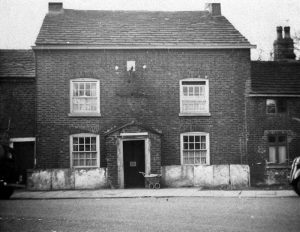
Cock – listed in Piggot’s Commercial Directory 1834, and known to have been at Bollington Cross, but may be a reference to what is now the Cock & Pheasant. From before 1841 to at least 1850 James & Sarah Clark(e) ran The Cock. Their son Richard Clark(e) who went on to form Richard Clarke & Co Ltd based in Reddish, Manchester, which maintained various links with Bollington. This business was eventually bought by Boddingtons Brewery in 1962. We thank descendant Simon Clarke for this information regarding his family.
In 1896 John William Pritchard ran the Cock & Pheasant.
Dagger Club – This was in Store Street, the building until early 2015 occupied by Bob Rigby’s photographic shop. One informant suggested that it was at one time the Liberal party club house.
Drum & Monkey – 116 Bollington Road, was previously named the The Ivy House Tavern and was lived in by a silk weaver seventy five year old Thomas Butterworth in the 1871 census.
Farmers Arms – Someone told me there was once a pub of this name; also mentioned by Broster. Mark Lovatt tells us that “It didn’t exist. The story came from a typo in the ‘County of Chester Detailed Return of Fully Licensed Houses and Beer houses 1891’ which erroneously listed Elizabeth Snape, Farmers Arms, Bollington (amongst several other mistakes); it should have read ‘Turners Arms‘. Several pubs in Bollington were or had been farms or were owned by farmers though.”
Flying Horse – Lost in the local authority’s reduction of licences in 1909. Anthony Holland tells me that it was at Nos.3 and 3A Oldham Street. In the 1934 book by Rev R. Norton Betts (see Books page) it is reported to have been in Simister’s Row, a small ally about 50m along from the Waggon & Horses. However, the weight of opinion from older residents suggests that the reverend got it wrong – and what would he know about pubs anyway! – and that it was indeed in Oldham Street. But does this mean there was another pub in Simister’s Row? The Flying Horse was leased to Heaver Brothers. Note that on the 1881 census the Flying Horse was indeed on Oldham Street and run by David Hulme from Lancashire aged seventy two and his seventy five year old Bollington born wife Hannah along with their fifty year old spinster daughter Ann.

Grapes – Lost in the local authority’s reduction of licences in 1909. This pub was at 10 Church Street (left), between The Turner’s (previously New Con Club, Turner’s Arms) and the Church House. The house there now once had an archway through it which was possibly an access to the yard behind the Grapes. However, it is not visible in the picture. The Grapes’ brew house was opposite the pub, off the picture to the right.
Horse Shoe – a beer house whose landlord in 1837 was one William Holland. He appears in trade directories of the time as a blacksmith – the two go together well! But where was the Horse Shoe inn?
 Lord Nelson – a beer house next door to Water Street Centre
Lord Nelson – a beer house next door to Water Street Centre![]() , known today as Nelson Cottage. In the mid 1800’s the Landlord was a Mr Williamson. The pub was managed by Robert Thompson in 1891, by William Bunting in 1902, and by John William Ridgway in 1914. It closed on 21st February 1922. Clarkes of Reddish were listed as the owners. My grateful thanks to Paul Wreglesworth for much of this information and for correcting my previous mistaken information.
, known today as Nelson Cottage. In the mid 1800’s the Landlord was a Mr Williamson. The pub was managed by Robert Thompson in 1891, by William Bunting in 1902, and by John William Ridgway in 1914. It closed on 21st February 1922. Clarkes of Reddish were listed as the owners. My grateful thanks to Paul Wreglesworth for much of this information and for correcting my previous mistaken information.
Lowthers Arms – actually at Pott Shrigley. Before it was a pub, the building used to be Pott Hall Farm. The building still stands, and is the house with the pretty windows opposite Pott Hall (thanks Jo Hadfield). We know very little about this pub other than it is thought to have been “closed down in the 1920’s by Lady Lowther, supposedly after she smelt alcohol on the breath of her groom!” (thanks Jim McIntosh).
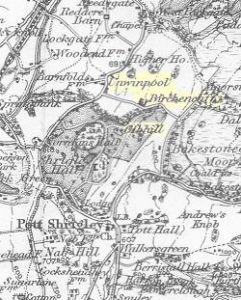 Robert Sharp has very kindly emailed “A distant ancestor, Edward Unwin b.1797, appears in various censuses as a publican, living in Pott Village in 1841, as an innkeeper in Pott (near Unwin Pool?) in 1851, and as a retired publican in/on Gibhill (near Birchencliff cottages?) in 1861. He died in 1866. … Alas, no pub is mentioned next to the census entries for Edward Unwin. Might he have been the landlord? Any light you can shed on this would be very gratefully received.” If you know more please let me know. The 1912 map (left) shows the three places mentioned in Robert’s note.
Robert Sharp has very kindly emailed “A distant ancestor, Edward Unwin b.1797, appears in various censuses as a publican, living in Pott Village in 1841, as an innkeeper in Pott (near Unwin Pool?) in 1851, and as a retired publican in/on Gibhill (near Birchencliff cottages?) in 1861. He died in 1866. … Alas, no pub is mentioned next to the census entries for Edward Unwin. Might he have been the landlord? Any light you can shed on this would be very gratefully received.” If you know more please let me know. The 1912 map (left) shows the three places mentioned in Robert’s note.
Navigation – is now Aqueduct Cottage beside the canal on Hurst Lane. It is said to have lost its licence in about 1905 (or maybe the 1909 cull) after the wives of mill workers objected to their men folk going in there after they were paid on a Thursday and spending all the housekeeping before going home! In those days it was very often the wives who managed the family finances – though 10/6 (pronounced ‘ten and six’, that is 10 shillings and 6D [D used to mean pence!] or 52½p in today’s decimal money) could hardly be regarded as finance, but the family had to live on it for a week! The canal horses were lodged overnight in stables beneath the house for a few pennies. It has come to light that this pub was possibly called The Aqueduct Inn before it was the Navigation Inn. It is said it closed in 1872 when magistrates refused to transfer the licence to a Michael Trino. Perhaps this was when it’s name changed.
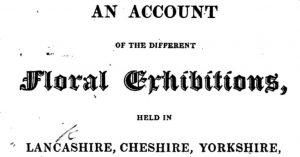 Orange Tree – at the bottom end of Flash Lane and now buried beneath the Silk Road. Various dates of opening have been put forward including 1899, pre-1882, and pre-1831. It is believed by some to have lost its licence in 1909. Mark Lovatt says that “Hearsay is that it was closed after a daughter of the Brocklehurst family was involved in a fatal accident outside the pub, early 1900’s. It is also on the 1882 Ordnance map so it must have been built earlier than [that].
Orange Tree – at the bottom end of Flash Lane and now buried beneath the Silk Road. Various dates of opening have been put forward including 1899, pre-1882, and pre-1831. It is believed by some to have lost its licence in 1909. Mark Lovatt says that “Hearsay is that it was closed after a daughter of the Brocklehurst family was involved in a fatal accident outside the pub, early 1900’s. It is also on the 1882 Ordnance map so it must have been built earlier than [that]. 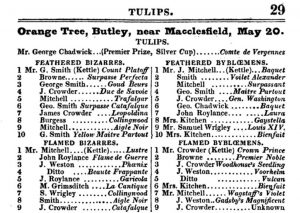 No other details known.” We now have evidence that the Orange Tree was open in 1831. Daniel Smith has kindly forwarded information regarding the Butley Tulip Society which “… ran for the best part of 80 years, holding its last show at The Orange Tree in 1901.” A record of the show can be found in Google books – An account of the different floral exhibitions, held in Lancashire, Cheshire, and Yorkshire, and other parts of the Kingdom in … 1831, etc – Google Books.
No other details known.” We now have evidence that the Orange Tree was open in 1831. Daniel Smith has kindly forwarded information regarding the Butley Tulip Society which “… ran for the best part of 80 years, holding its last show at The Orange Tree in 1901.” A record of the show can be found in Google books – An account of the different floral exhibitions, held in Lancashire, Cheshire, and Yorkshire, and other parts of the Kingdom in … 1831, etc – Google Books.![]() Mrs Kitchen is listed as an exhibitor; Daniel also adds that she was the licensee at the Orange Tree at the time, 1831.
Mrs Kitchen is listed as an exhibitor; Daniel also adds that she was the licensee at the Orange Tree at the time, 1831.
See the picture at the Discovery Centre . Confusion could have arisen because on the 1874 map it is shown as the Flash Inn. Though marked as an Inn on the 1896-1904 map it is without a name.
Post Office Inn – Mentioned in Looking Back at Bollington by George Longden & Molly Spink (see Books page). Mark Lovatt writes “The Post Office Inn was located immediately south of the ‘Waggon and Horses‘. I remember seeing a photograph of it and seem to remember it being set back a little, behind what used to be the butchers. The original ‘Waggon’ was also set back a little off the road, before being replaced by the [recently demolished (2020)] building by the [North Staffordshire] Railway Company in 1907. The ‘new’ Waggon may also have been referred to as the ‘Railway‘ or the ‘Blazing Rag‘. [This is] marked on the 1881-82 Ordnance Survey [map].” But see immediately below regarding the Railway …
Railway Inn – Mentioned in Looking Back at Bollington by George Longden & Molly Spink (see Books page). Daren Hooley writes to say that “… the 1881 Census shows that my great, great grandfather, John Hooley lived in the Railway Tavern on Princess Street.” (Immediately below Rose Bank.) Please email me if you know more. Also see the Post Office Inn immediately above.
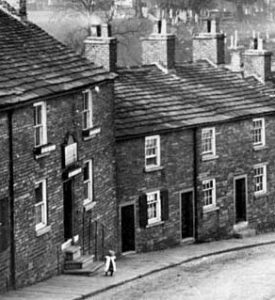
Rising Sun – Noted by Betts (1934) (see Books page) as once a beer house in Lord Street, numbers 21 and 21A. Thought to have been named after the rising sun embossed plate which was found affixed to the wall of Heaver’s Brewery after the latter was burnt down in 1931. The pub had already closed in 1924, but continued as a sweet shop. Personally I suggest that its elevated position facing east has more to do with it! The rising sun plate was probably an insurance mark (the Sun Insurance Co.) to ensure the fire brigade attended.
Shoulder of Mutton – listed in Piggot’s Commercial Directory 1834. Most probably an earlier name for the Holly Bush Inn.
Steam Engine Inn – in the 1911 census the landlord was John Hilton aged 53. Mark Lovatt writes “This was in the terrace south of the Cock & Pheasant, at 35 Bollington Road, where a small front garden wall protrudes onto the pavement and is quite obvious when you see it. I don’t know when it closed, but my grandmother (Annie Abbott, 1904-2001) remembered it. This is another contender for the ‘Blazing Rag‘. [This is] marked on the 1881-1882 Ordnance Survey [map].” It seems to have been known as the Steam Carriage in the 19thC.
Alan Swindale was also kind enough to write “According to the 1891 census, Harriet Swindells, the 64 year old widow of William Swindells, was the publican at the Steam Engine at that time.”
Dave Smith also most generously shared with me a legal Memorandum of Agreement dated 6th December 1899 in which Ralph Nield is engaged as tenant to run a beer house known as the Steam Engine Inn at Bollington Cross from the quarter day, 26th December 1899. The pub was then owned by Richard Clarke & Company Limited, brewers at the Westgate Brewery in Stockport at least within the years 1894 – 1961 (Stockport Archive Service).
Peter James kindly wrote with some history on his great great grandfather, Ralph Nield, born December 1846 in Hyde, Cheshire, lived and worked in Stockport as a [steam] engine driver in a cotton mill, moved to Bollington in December 1899 to run the pub, died in July 1912.
If you know more please email me.
The Ivy House Tavern – Mark Lovatt writes “The Ivy Tavern was (is) the last house in Bollington Cross on the left hand side when heading towards Macclesfield, 116 Bollington Road, … facing ‘The Rookery’. [This is] marked on the 1881-1882 Ordnance Survey [map].” Later known as the Drum & Monkey.
Waddling Duck – 10 & 12 Lord Street. The cellar was filled in some time after it ceased to be a pub. However, it was dug out again when the houses were re-furbished in the 1990s. The name probably arises from the fact that it was adjacent to a ford across the river before the bridge was built. There would have been plenty of ducks in the road.
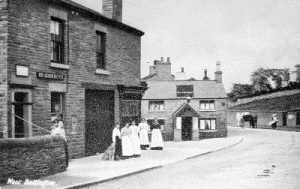
Waggon & Horses – the original Waggon & Horses inn was demolished and replaced by the North Staffordshire Railway Company (NSR, the Knotty) in 1907 with a building that was itself demolished in 2020 – it had become an Indian restaurant. A new building under construction will have a shop on the ground floor and the Indian restaurant on the top floor. The original building is pictured left; it’s the little low building! I am grateful to Jan Pusey who tells me that her ancestors John & Sarah Bowden (nee Mottershead) were in the pub in 1891. And according to Kelly’s Directory Arthur Blease was running the Wagon & Horses (one ‘g’ or two have both been used and are correct spelling) and in 1909 to 1915 approx. William Woodall was the Landlord formerly living at 9 Princess Street.
Weavers Arms – listed in Piggot’s Commercial Directory 1834. Do you know where it was? Please email me if you do.
I have been told that there was once a pub on the corner of Palmerston Street and Church Street (Shrigley Court stands there now). In a 1958 picture we can see that it was a corner shop, newsagent, but it may well have been a pub in earlier years – perhaps one that lost its licence in the 1909 cull. Any ideas? Please email me if you know anything about this.
Laura Beresford has very kindly told me about the houses on the topside corner of Shrigley Road and Beeston Mount. According to the deeds these were once a beer house. Not yet sure of the name, but perhaps this was also one that lost its licence in the 1909 cull. Any ideas? Please email me if you know anything about this.
More recently …
We have lost some in the last few years:
The Barge Inn – only opened for a few years in the late 1980s and early 1990s on the canalside at Adelphi Wharf. Lost about 1995 when the associated Adelphi Hotel went out of business.
 Cheshire Hunt – converted to a house and cottages in 2001/2. The picture (right) is thought to have been taken in about 1950 – the young lad in the doorway was John Snape, son of the licensees Nancy & Hedley Snape. Thanks and credit to John’s daughter Dawn Davies.
Cheshire Hunt – converted to a house and cottages in 2001/2. The picture (right) is thought to have been taken in about 1950 – the young lad in the doorway was John Snape, son of the licensees Nancy & Hedley Snape. Thanks and credit to John’s daughter Dawn Davies.
I am indebted to Harold Skelhorn and Paul Wreglesworth for bringing to my notice a very interesting story about this pub. In the late 1800s it changed its name to the Cheshire Hunt. Previously it had been known as the Quiet Woman.
Harold tells me that around 1950 he took the school bus each day which passed this pub. Some renovation work was being carried out and he noticed that the roadside pub sign showed that it was the Quiet Woman, and this was painted over with Cheshire Hunt. Harold said “The old picture showed the head of a woman inside what looked like a dome shaped bird cage. The painting portrayed the woman with a very large tongue hanging from her mouth trapped with a large mouse trap!” Not very PC today – I can’t see us getting that re-instated! (The pub name has been in use up at Earl Sterndale, near Buxton, but their picture is somewhat more acceptable – they just cut her head off! That pub closed in 2020.)
In the 1950s – early 1960s The Cheshire Hunt was run by Hedley and Nancy Snape. Nancy died 18 June 2018 aged 97. (Thanks to Polly Kirkham for the info.)
Additional information may be found at That’s the Hunt Over![]() with a picture at bollington_cheshirehunt.jpg.
with a picture at bollington_cheshirehunt.jpg.
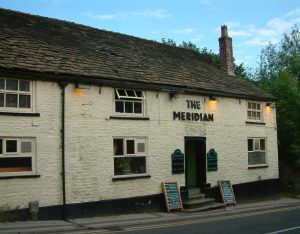 Meridian – once owned by the Clarke’s brewery in Stockport, closed in August 2006 but re-developed in 2007 into The Plaice fish restaurant and takeaway. In 1850 the Meridian Inn was run by
Meridian – once owned by the Clarke’s brewery in Stockport, closed in August 2006 but re-developed in 2007 into The Plaice fish restaurant and takeaway. In 1850 the Meridian Inn was run by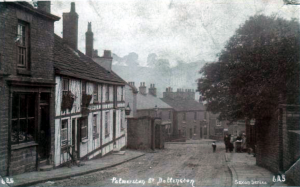 Charles Perkins. Alan Wain, whose mother was an Oldfield, tells me that his aunt Winifred and husband Ralph Clayton ran the Meridian during WWII (early 1940s). Following the Claytons it was then owned by Clarke Brewery in Stockport. The Meridian was noted for it’s skittle alley which Alan remembers playing. It was along one side of the bar, which was finished with black and white checkered tiles! I, too, remember the black and white tiles, so they were still there in the late 1970’s. It was for some years a Moroccan restaurant before final closure and refurbishment (almost a re-build) to create The Plaice. That closed in 2013, only for the takeaway half of the building to open as the Indian Express takeaway in October 2014. This lasted only a year before closure and conversion of the building into two domestic units. Just to confuse matters, the Meridian was once called the Royal Oak.
Charles Perkins. Alan Wain, whose mother was an Oldfield, tells me that his aunt Winifred and husband Ralph Clayton ran the Meridian during WWII (early 1940s). Following the Claytons it was then owned by Clarke Brewery in Stockport. The Meridian was noted for it’s skittle alley which Alan remembers playing. It was along one side of the bar, which was finished with black and white checkered tiles! I, too, remember the black and white tiles, so they were still there in the late 1970’s. It was for some years a Moroccan restaurant before final closure and refurbishment (almost a re-build) to create The Plaice. That closed in 2013, only for the takeaway half of the building to open as the Indian Express takeaway in October 2014. This lasted only a year before closure and conversion of the building into two domestic units. Just to confuse matters, the Meridian was once called the Royal Oak.
Redway Tavern – closed 2003. Returned to cottages in 2004/5. When I knew it in the late 1970s/ early 1980s it was a very popular pub, with a good room for functions. Somehow it just lost its way.
The Vale Inn – closed for seven years then re-opened in September 2002 only to close again in April 2004. However, it re-opened again in March 2005 and is now one of the most successful pubs in Bollington! It is one of only two Free Houses* (the other is the Poachers), which might have something to do with it! It also has its own micro-brewery, Bollington Brewing Co., producing the most delicious prize-winning beers! That’s a first in Bollington for about 80 years. Bollington Brewing Co.![]() now own four pubs (10/2021), the Vale, Cask Tavern in Poynton, Park Tavern and The Fountain in Macclesfield.
now own four pubs (10/2021), the Vale, Cask Tavern in Poynton, Park Tavern and The Fountain in Macclesfield.
* Free Houses – a free house is one that is free to choose beers from any brewer without being tied to a particular brewer or pub company. Strictly speaking, on that basis, the only true Free House in Bollington is the Poacher’s Inn which is owned by its licensee. The Vale Inn is owned by Bollington Brewing Co. and so sells that company’s beers, but can and does choose to stock beers from other brewers. The recently closed Crown Inn was in a similar situation, it’s owners also owning another pub, the Ox-fford in Macclesfield, together with a small brewery. The Turners is an independent members club which is also free to choose its beers.
Financial downturn and changes in drinking habits
From 2008 the country was in a bad way financially and there began a period of difficulty for the pub industry. Many pubs had been acquired in the previous eight years by companies (Pubcos) specialising in the ownership of pubs but were not breweries. All this was done on borrowed money. The cost of the debt resulted in sky high rents for landlords and they also had a limited selection of beers available to them and at high prices too, supplied through the Pubcos. The following pubs were casualties during this period of difficulty.
Highwayman – really a Rainow pub but always listed on this web site, it closed in January 2010 and its future looked bleak. It re-opened for a short time but then closed for good. It has been converted into a domestic residence (2013-15).
The late Graham Hibbert very kindly sent me the following story about the Highwayman – “When I was a teenager [1950s] we would often go to ‘The Patch‘ for a night out. Everyone in Rainow, Bollington and beyond knew The Patch. It was the perfect country pub with three open fires and a well used piano. Delicious chicken sandwiches with wonderful home made stuffing were always available. I am referring to the Blacksmiths Arms, still puzzled? In about 1956 Bill Oldham the then landlord changed the name to The Highwayman. Why everyone knew it as The Patch was a mystery but it was thought it was this that led to the landlord’s choice of the new name. Long after Bill Oldham, and later his son, Neville Oldham, retired came the idea of serving gourmet food at gourmet prices along with the drink drive laws which would lead to the demise of this wonderful pub. Steeped in history.” Why was it called ‘The Patch‘? Because it was originally a house called ‘Patch House’, as shown on old maps from as early as 1805, to as late as 1948. Also, it is shown on the 1930s to 1950s Ordnance Survey maps as a PH (public house) named ‘Patch House’.
Rising Sun – another Rainow pub lost in about 2011 and converted to domestic use (2013-14).
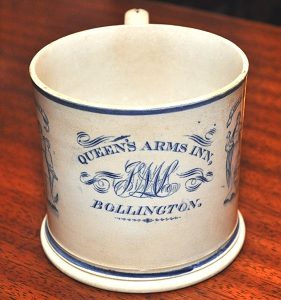

Queen’s Arms – in High Street opposite the junction with Water Street, it closed in 2012 and has been converted into three domestic dwellings (2014). This pub suffered from lack of appeal, a small catchment area for regulars, and a bad reputation for drugs.
To the left are pictures of an early 19thC large (1 quart) presentation mug with the Odd Fellows emblem or seal on it (right picture) and the recipient’s initials along with the ‘Queen’s Arms Inn, Bollington.’ (left picture). This beautiful piece, in perfect undamaged condition, was found in the USA in the early 21stC and very carefully conveyed back to the UK, where it is in the hands of a local collector. It is probable that it was among the chattels of someone who emigrated from Bollington to North America in the late 19th or early 20thC. It’s done well to survive! We know that one Isaac Lucas was instrumental in setting up the ‘Honest Endeavour Lodge’ of Odd Fellows at the Queen’s Arms in 1824, indeed, he bought the pub in order to do so, see his page. So it is probable that the pot belonged to an earlier Lodge which either moved or ceased activity.
We also have a copy of the Rules of the ‘Fountain of Friendship Lodge’ of The Bollington District of Independent Order of Odd Fellows![]() in which it states that they are based at the Dog & Partridge. There follows detailed instructions on how the location for their meetings can be changed.
in which it states that they are based at the Dog & Partridge. There follows detailed instructions on how the location for their meetings can be changed.
Red Lion – at the top of High Street, closed after a prolonged period of poor business on 17 July 2013. Has been converted into a domestic dwelling.
Royal Oak – in Princess Street, the only proper pub in West Bollington closed in 2013 and has been converted into a domestic dwelling. (One can also drink at the Bay Leaf Indian Restaurant.) Mr & Mrs France were the licensees here in 1881 when they provided ‘a substantial knife-and-fork tea’ to celebrate the wedding of Mr John Bradley Ledley and Mrs Hannah Wilson.
Two pubs have been called by this name, the other is listed below.
Holly Bush – in Palmerston Street closed for a significant time since 2013. Now fully re-furbished and re-opened from 01/04/2016!
Regrettably there are other local pubs which might be considered to be ‘at risk’. Time will tell.
The 2020 coronavirus pandemic
Beginning in March 2020 in the UK, the 2020 coronavirus (Covid-19) pandemic resulted in the ‘temporary’ closure of every pub, restaurant and café throughout the country. This inevitably had a devastating effect on trade. Premises were permitted to re-open in July 2020, but there were strict rules in order to maintain ‘social distancing’ of two metres. Many establishments began serving takeaway food and drink. The rules were further tightened in early October when face masks had to be worn when standing inside. All customers had to be seated and served at table. From mid-October those seated at any table were limited to one household and pubs had to close by 10pm. All this seriously limited the sociability of pub life and drastically reduced occupancy levels. In October, the government implemented a postcode based three tier system with increasing levels of restriction depending on the prevalence of Covid-19 in a district. Bollington began in Tier 2, which permitted pubs to open under the rules noted above.
The first Covid-19 victim in Bollington was the Crown Inn in Church Street. The owners, Junction Leisure Ltd., who also own the Ox-fford in Macclesfield, decided that the Crown was no longer viable and obtained planning permission to convert the building to residential occupancy, two units plus three new units in the car park.
Rebuilt …
Dog & Partridge – the present building was built about 1900, and facing Palmerston Street. There is evidence of an earlier Dog & Partridge (D&P) on the same site but facing Round Gardens. We have a record of a publican of the D&P – Thomas Ainsworth b.1761 d.1827, Innkeeper at the D&P 1802-1805, m.1795 to Jane Richardson, also Aaron Oldfield b.1800 d.1885, held the D&P c.1841-1871. Why the about face? Round Gardens was the original road through that part of Bollington. In about 1830 (while the canal was under construction) they built a wider and straighter road, Great High Street, on the other side of the original D&P all the way to Bridgend and beyond which we know today as Palmerston Street.
Renamed …
Masonic Arms – certainly not lost; just renamed as the Poacher’s Inn. It had yet another name before it was the Masonic – it started out as the Mason’s Arms.
Royal Oak – no not the 20thC one in Princess Street, but an earlier name for the Meridian.
Shoulder of Mutton – listed in Piggot’s Commercial Directory 1834. The Civic Society historic archive has a press cutting dating from around 1968, probably from a Macclesfield paper, in which Jesse Beard (who was a small boy in 1880) noted that his father kept the Holly Bush Inn in Palmerston Street when it was known as the Shoulder of Mutton. Beard senior brewed once a fortnight. The archway to the right of the pub was used as a slaughterhouse and during the time of serious unemployment when the cotton industry was in decline (1890s?) Beard senior boiled up broth in the archway for the local population.
Turner’s Arms – re-cycled as The Turner’s (previously the New Con Club – the old Conservative Club moved), though effectively one pub lost because the old Conservative Club in Adlington Road is now an office. The Turner’s, as it has always been more commonly known, had its glasses engraved to establish ownership.
Waggon & Horses – closed through the autumn of 2006 and re-opened after refurbishment on 6th December 2006 as the Bayleaf lounge, bar & restaurant, so, in reality, that’s another pub lost. In March 2020 the entire premises were demolished and have been re-developed with a shop on the ground floor and the Bayleaf restaurant on top.
Brewers and Bottlers
There were many beer houses that brewed their own beer and many of those listed above did that. There were also a small number of independent brewers and the biggest was Heaver Brothers. Brewers and Bottlers have their own page.
Others include Pimlott & Co., George H Gill and Greenwood & Gill. Not sure if Gill is the same chap in both businesses. We have bottles from each of these.
Everyone knows Frederic Robinson Ltd.![]() , brewers of the Unicorn Brewery in Stockport. But very few know that William Robinson started out as a Bollington publican before moving to the Unicorn Inn in Lower Hillgate, Stockport, in September 1838 (William? Frederic?). Unfortunately we don’t yet know which pub he had in Bollington and whether he brewed his own beer, as many of the small beer houses did in the early 1800s.
, brewers of the Unicorn Brewery in Stockport. But very few know that William Robinson started out as a Bollington publican before moving to the Unicorn Inn in Lower Hillgate, Stockport, in September 1838 (William? Frederic?). Unfortunately we don’t yet know which pub he had in Bollington and whether he brewed his own beer, as many of the small beer houses did in the early 1800s.
Acknowledgements
I am most grateful to those who have provided additional information on the old pubs of Bollington. This page has become a very interesting collection of pub heritage as a result.
Please let me know of any other old pubs of Bollington or anything else you know about those already listed – please send me a message!
Your Historic Documents
Please don't chuck out those historic documents and pictures! Find out why here.